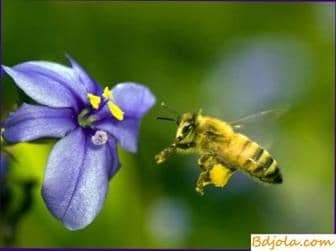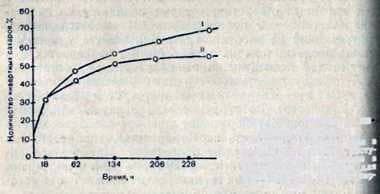Inversion of sucrose
 The main component of nectar is sucrose. It is a complex sugar that is not absorbed through the walls of the intestine into the blood either from the bee or from the person. But in the process of digestion, sucrose decomposes into two simple sugars: glucose (grape) and fructose (fruit). The decomposition of sucrose in the digestive system of animals and humans occurs under the influence of the enzyme invertase, and the process itself is called the inversion of sugar. It occurs simultaneously with the removal of excess water from the nectar.
The main component of nectar is sucrose. It is a complex sugar that is not absorbed through the walls of the intestine into the blood either from the bee or from the person. But in the process of digestion, sucrose decomposes into two simple sugars: glucose (grape) and fructose (fruit). The decomposition of sucrose in the digestive system of animals and humans occurs under the influence of the enzyme invertase, and the process itself is called the inversion of sugar. It occurs simultaneously with the removal of excess water from the nectar.
Invertase is produced in the pharyngeal gland of the bee located in the front of the head. The gland consists of two long, writhing ducts, around which are located the alveoli, consisting of several large secretory cells. The iron has two outlets, which are on the pharyngeal plate – in the cavity, where the nectar coming from the proboscis is absorbed. The pharyngeal gland in a young bee, after leaving the cell, develops rapidly and in the first two weeks of life it secretes the secret which constitutes the main part of milk for larval feeding. At this time, invertase, although it is isolated, but in a small amount. In the second half of life, when the bee ceases feeding the larvae and goes on to flight work, the iron is rebuilt, its activity increases to isolate the invertase. It reaches its greatest intensity from the 20th to the 30th day of the life of the bee. Then the activity of invertase decreases, and old bees do not distinguish it completely.
In strong families, bees pass to flying work earlier than in weak ones. Accordingly, in bees from the strongest families, the active in vitro release phase begins. Bees of the spring generation grow brood longer, so the active release of invertase in their “begins later.
Already during the absorption of nectar from flowers, the secret of the pharyngeal gland is mixed with it and the inversion
The bee, who has collected nectar in the honey cind, settles somewhere on the honeycomb head to the top and then straightens it, draws the proboscis. On the elongated, slightly curved proboscis, the bee releases a drop of nectar, which appears to be suspended to the proboscis. Then the bees gradually straighten the proboscis, and the nectar is again drawn into the pharynx and the honey cind. The bee lets out many times and again draws in a drop of nectar. Having graduated; work, she puts nectar in a cell. When passing through the proboscis, the secret of the pharyngeal gland is added to the nectar every time, which enriches the nectar with enzymes that accelerate inversion and protein.
In the experiment, after feeding the bees with pure sugar syrup (there is no protein in it), 0.08% protein was found in the syrup; After re-feeding the same syrup, the protein content increased to 0.14%.
In the acceleration of the inversion of sucrose, multiple transfers of ripening nectar from one cell to another are important, in which each time the bee adds a secret to the nectar containing the invertase. An employee of the Institute of Apiculture in his experience fed 50% sugar syrup to the families of bees, which the bees put together in honeycomb cells. After 18 hours, 50% of the cells with folded food in each honeycomb were covered with a dense metal mesh to deprive the bees of access to the ripened forage.

Fig. 11. The rate of sucrose inversion:
I – the food in the cells was at all times available to bees; II – food in the cells was available to bees only during the first 18 hours
Figure 11, which depicts the rate of sucrose inversion in cells with free access to them by bees (the upper curve) and in cells enclosed by a metal mesh (lower curve), shows that the access of bees to the forage significantly accelerated the process of inversion.
The activity of enzymes in maturing nectar is affected by the amount of nectar entering the hive per day. When collecting nectar with small droplets (by licking the tongue) in honey crab, there is more invertase than with rapid absorption of it. It is noticed that the feeding of bees with sugar syrup from the feeder always enhances the secretion of the pharyngeal glands.
Inversion of sucrose continues and after sealing honey in cells with wax lids. In freshly sealed honey, up to 6% sucrose may be present; with time, the amount of it is reduced to 1% or less.
In drones and queens, the pharyngeal glands do not contain invertase; they do not participate in the processing of nectar, but eat already ready honey.
The bee family can contribute 8-12 kg and more nectar per day. The bees process all this nectar, consuming energy and protein, which is part of the enzyme. Bees prepare carbohydrate food (honey), which is absorbed directly from the intestine into the blood (hemolymph) and absorbed by the cells of the body without any cost for digestion.
Inversion of sucrose
